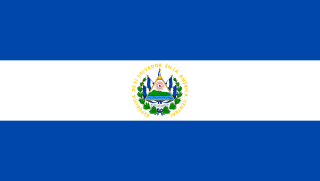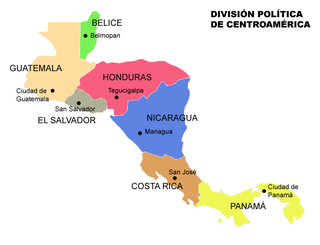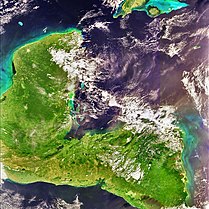
Central America is a region in the southern tip of North America and is sometimes defined as a subregion of the Americas. This region is bordered by Mexico to the north, Colombia to the southeast, the Caribbean Sea to the east and the Pacific Ocean to the west and south. Central America consists of seven countries: El Salvador, Costa Rica, Belize, Guatemala, Honduras, Nicaragua and Panama. The combined population of Central America is estimated at 44.53 million (2016).

El Salvador, officially the Republic of El Salvador, is the smallest and the most densely populated country in Central America. It is bordered on the northeast by Honduras, on the northwest by Guatemala, and on the south by the Pacific Ocean. El Salvador's capital and largest city is San Salvador. As of 2018, the country had a population of approximately 6.42 million, mostly consisting of European and Native American descent.
The music of Latin America refers to music originating from Latin America, namely the Romance-speaking countries and territories of the Americas and the Caribbean south of the United States. Latin American music also incorporates African music from slaves who were transported to the Americas by European settlers as well as music from the indigenous peoples of the Americas. Due to its highly syncretic nature, Latin American music encompasses a wide variety of styles, including influential genres such as cumbia, bachata, bossa nova, merengue, rumba, salsa, samba, son, and tango. During the 20th century, many styles were influenced by the music of the United States giving rise to genres such as Latin pop, rock, jazz, hip hop, and reggaeton.
The music of Belize has a mix of Creole, Mestizo, Garìfuna, Mayan and European influences.
Panama is a Central American country, inhabited mostly by mestizos. The music of Panama is heavily based on the folk music of Spain, particularly that of Andalusia and was influenced first by the indigenous populations of Kunas, Teribes, Ngobe Bugle and others, and then by the black population who were brought over, first as slaves from Africa, between the 16th century and the 19th century, and then voluntarily to work on the Panamanian Railroad and Canal projects between the 1840s and 1914.

The Garifuna people are a mixed African and indigenous people originally from the Caribbean island of Saint Vincent who speak Garifuna, an Arawakan language.
Music of Nicaragua is a mixture of indigenous and European, especially Spanish, influences. Musical instruments include the marimba and others that are common across Central America. Pop music includes Cuban, Brazilian, Mexican and Panamanian performers, as well as those from Europe and the United States.
The music of Guatemala is diverse. Music is played all over the country. Towns also have wind and percussion bands that play during the lent and Easter-week processions as well as on other occasions..

The music of El Salvador has a mixture of Lenca, Cacaopera, Mayan, Pipil, and Spanish influences. This music includes religious songs used to celebrate Christmas and other holidays, especially feast days of the saints with Tubular bells Chimes. Satirical and rural lyrical themes are common and played with Xylophone.
The music of Honduras is very varied. Punta is the main "ritmo" of Honduras with other sounds such as Caribbean salsa, merengue, reggae, and reggaeton all widely heard especially in the North, to Mexican rancheras heard in the interior rural part of the country. Honduras' capital Tegucigalpa is an important center for modern Honduran music, and is home to the College for Fine Arts.
Garifuna music is a type of music found in Central America, primarily on the Caribbean coast of Belize, Guatemala, Honduras, and Nicaragua.
Punta rock or Belizean punta is a form of the traditional punta rhythm of the Garifuna people of Belize, El Salvador, Guatemala, Honduras. Although most artist and bands are exclusively Garifuna, songs are usually in Kriol or Garifuna and rarely in Spanish, or English.

Punta is a dance and music originated by the Garifuna people with African and Arawak elements.
Latin American culture is the formal or informal expression of the people of Latin America and includes both high culture and popular culture as well as religion and other customary practices.

Central America is a subregion of the Americas formed by six Latin American countries and one (officially) Anglo-American country, Belize. As an isthmus it connects South America with the remainder of mainland North America, and comprises the following countries : Belize, Guatemala, Honduras, El Salvador, Nicaragua, Costa Rica, and Panama.

Hondurans are people inhabiting in, originating from, or having significant heritage from Honduras. Most Hondurans live in Honduras, although there is also a significant Honduran diaspora, particularly in the United States, with smaller communities in other countries around the world. There are also people living in Honduras who are not Hondurans, because they were not born or raised in Honduras, nor have they yet gained citizenship.

This is an Index of Central America-related articles. This index defines Central America as the seven nations of Belize, Costa Rica, El Salvador, Guatemala, Honduras, Nicaragua, and Panama.

The City of Houston includes a significant population of Central American origin, including origins from El Salvador, Guatemala, Honduras, and other countries.
Paranda is both a Garifuna rhythm and music with Arawak and African elements which utilizes rhythmic ostinatos in duple meter. Similar to punta, the paranda is a slower rhythm than punta and reflects Spanish influences. Traditionally, the guitar is played in paranda and not in punta. and its melodies are soulful lamentations.








